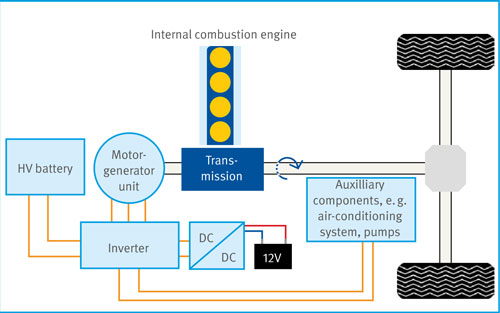Abschnitt 4.2 - 2. Training for work relating to production and commissioning during the manufacturing process
2.1 Assembly
Production of an HV system necessitates electrical work. Control and supervision of this electrical work within the assembly process can be exercised by the responsible man-management personnel based upon standardized working procedures. This necessitates the formulation of binding work instructions which contain the procedure to be followed during this work, including the hazards which arise and the associated protective measures to be taken. Review of the standardized work instructions for their technical correctness is the task of a skilled electrical person, who owing to his or her sound knowledge and skills is qualified for this task.
The topics covered by the work instructions must be communicated to the employees by familiarization (for example in the course of product training) or instruction. The employees must understand the material.
The relevant superiors are responsible for sustained integration of the standardized work procedures into the production process, generation of the requisite documentation, and monitoring of implementation.
2.2 Commissioning following assembly
Once the HV system has been commissioned by connection to the power source, the hazard potential increases. Depending upon the task to be performed on the vehicle, this may necessitate further training measures for the employees. The following distinctions in particular, which take account of differences in hazard potential, must be drawn in this context:
- a)
Commissioning of batteries with full protection against accidental contact and arcing
Commissioning is adequate if performed in accordance with standardized work procedures (as described for assembly) by a person who has received electrical instruction.
- b)
Commissioning of batteries without full protection against accidental contact and arcing
Protection against electric shock and fault arcs is not assured by technical means alone. Such work may be performed only by employees qualified to Stage 2 in accordance with the stage model.
- c)
Reworking without faults in the HV
Should reworking not require intervention in the HV system, this work may be performed in accordance with standardized work procedures by a person who has received electrical instruction, as described for production-line assembly. This includes work on the conventional vehicle electrical system up to 30 V AC and 60 V DC.
- d)
Reworking with faults in the HV
Should electrical work be required on the HV system, its non-live state must be assured. This work requires an employee qualified to Stage 2 in accordance with the stage model. These provisions also include work on the conventional vehicle electrical system up to 30 V AC and 60 V DC if components of the HV system are affected.
Live work may be necessary for troubleshooting on the HV system. In this case, qualification to Stage 3 in accordance with the stage model is required.
2.3 Electrical tests
Where electrical tests are performed in the manufacturing/assembly process, for example tests of the continuity of the potential equalization, insulation tests, voltage tests, etc., the following distinctions must be drawn regarding the required qualification:
If the intrinsic safety of the HV system is not assured, employees qualified to Stage 3 must be tasked.
Where testing is performed with full protection against electric shock and fault arcing, qualification to Stage 2 is required if the measurement result is to be evaluated. If evaluation of the measurement result is not required, qualification to Stage 1 is sufficient.
The provisions of DIN EN 50191 (VDE 0104) and of the BGI 891 informative document (in german) must be observed.

